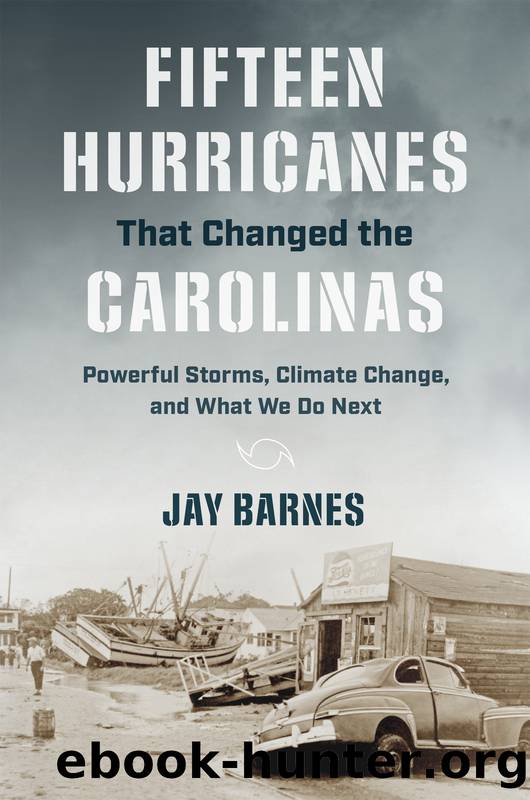Fifteen Hurricanes That Changed the Carolinas by Jay Barnes

Author:Jay Barnes
Language: eng
Format: epub
Publisher: The University of North Carolina Press
Published: 2022-08-15T00:00:00+00:00
An anxious crew of dogs looks for high ground after being rescued from the sunken neighborhoods of Princeville after Hurricane Floyd. (Photo by Dave Saville. Courtesy of FEMA.)
During Hurricane Dorian in September 2019, extreme tides swept across Pamlico Sound, flooding Ocracoke and other coastal islands with some of the highest water in memory. Thankfully, the ponies on Ocracoke and at Corolla, Shackleford Banks, and the Rachel Carson Reserve all fared well. Those at Cedar Island were not as fortunate; only twenty-one of the herd of forty-nine survived the inundation. In addition to the horses, the island was home to about twenty-five âsea cows,â cattle of unknown origin that have roamed free there for years. Most drowned during Dorianâonly about six survived. Three of the survivors made the news when they were discovered on the beaches of Cape Lookout National Seashore about a month after the storm. It was believed the trio swam or were carried about four to five miles across Core Sound to North Core Banks. The park service returned them to their Cedar Island home, and one was later named Dori, according to the Wild Horses of Cedar Island Facebook page.
During Hurricane Fran, thousands of trees toppled into pastures across North Carolina, some striking and killing horses and livestock. But some trees proved even more lethal in the days following the storm when horses that munched on the wilted leaves of fallen red maple, cherry, or elderberry branches became sick and died. The staff of North Carolina State Universityâs College of Veterinary Science scrambled to save what animals they could and issued warnings to horse owners to remove the downed trees as quickly as possible. Cherry tree leaves contain cyanide, and the leaves of all three species are highly toxic to horses and often lethal.
Waterfowl can be victims of severe hurricanes. Hunters report that ducks seem to disappear after these storms, perhaps seeking cover in areas farther inland. In the book Reflections of the Outer Banks by Donald and Carol McAdoo, former Corolla postmaster Johnny Austin described the effects of high winds on some waterfowl: âThe ducks and geese used to be so plentiful around here that when a storm came up it wouldnât be unusual to pick up $15 or $20 worth that had killed themselves flying into that top wire of the lighthouse. And you only got five or six dollars a barrel for them, depending on the kind they were, so it took a lot to mount up to $15.â
After Hurricane Fran, bird watchers near Raleigh were treated to a rare sightâhundreds of seabirds were spotted around the Triangle. As the storm pushed across the state, it carried with it a collection of birds usually found over the Gulf Stream, including petrels and an Audubonâs shearwater. Most of the inland sightings were near Jordan and Falls Lakes. Seabirds usually fly ahead of a hurricane but sometimes travel within the eye as it moves overland. They often drop out over large lakes, then rest before their return to the Atlantic.
Download
This site does not store any files on its server. We only index and link to content provided by other sites. Please contact the content providers to delete copyright contents if any and email us, we'll remove relevant links or contents immediately.
Man-made Catastrophes and Risk Information Concealment by Dmitry Chernov & Didier Sornette(5925)
The Revenge of Geography: What the Map Tells Us About Coming Conflicts and the Battle Against Fate by Kaplan Robert D(4036)
Zero Waste Home by Bea Johnson(3781)
COSMOS by Carl Sagan(3559)
Good by S. Walden(3489)
In a Sunburned Country by Bill Bryson(3486)
The Fate of Rome: Climate, Disease, and the End of an Empire (The Princeton History of the Ancient World) by Kyle Harper(3007)
A Wilder Time by William E. Glassley(2818)
Camino Island by John Grisham(2763)
The Ogre by Doug Scott(2634)
Organic Mushroom Farming and Mycoremediation by Tradd Cotter(2631)
Human Dynamics Research in Smart and Connected Communities by Shih-Lung Shaw & Daniel Sui(2466)
Energy Myths and Realities by Vaclav Smil(2439)
The Traveler's Gift by Andy Andrews(2411)
9781803241661-PYTHON FOR ARCGIS PRO by Unknown(2325)
Inside the Middle East by Avi Melamed(2305)
Birds of New Guinea by Pratt Thane K.; Beehler Bruce M.; Anderton John C(2226)
A History of Warfare by John Keegan(2186)
And the Band Played On by Randy Shilts(2131)
